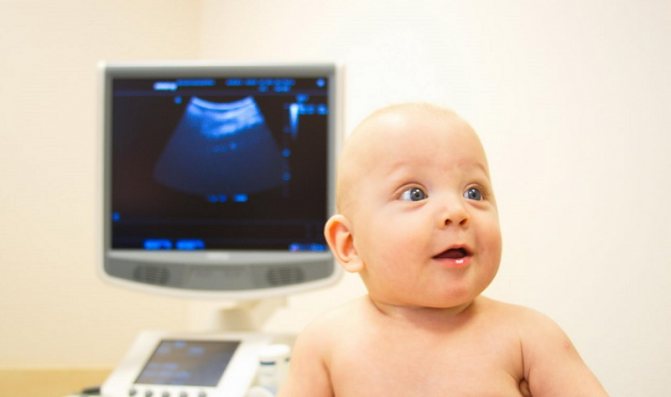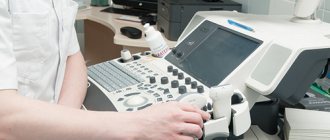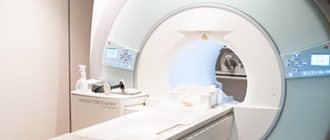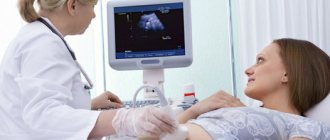Price list Doctors clinic
In pediatric gastroenterology, ultrasound diagnostics is in demand, namely ultrasound of the stomach (ultrasound of the upper gastrointestinal tract with a water-siphon test). The procedure for a child is completely painless, safe and allows you to obtain accurate data on the condition of the organ. It is better tolerated by young patients than gastroscopy, and unlike X-ray diagnostics, this method does not involve ionizing radiation, so it can be repeated as often as necessary.
Indications for the study
There are several indications for performing an ultrasound examination of the stomach or stomach and esophagus:
- pain in the epigastric region, upper abdomen;
- Frequent spitting up or episodes of nausea and vomiting in an older child;
- belching sour, rotten;
- heartburn, etc.
The method is used both as part of the primary diagnosis of diseases and as a tool for monitoring the effectiveness of treatment if the diagnosis is already known.
Where can I get an ultrasound of a child’s abdominal organs in Moscow?
"GD-Medicine" is a modern medical center that provides many services, including ultrasound examinations for adults and children. We have modern equipment that is used by highly qualified specialists, which allows us to obtain complete and accurate data on the condition of the abdominal organs.
The procedure is carried out in rooms where comfortable conditions are created for patients. After the ultrasound, the specialist will issue the results of the study, as well as a conclusion, on the basis of which the attending physician will make a diagnosis and prescribe the most effective course of treatment.
Make an appointment now. Our prices are quite reasonable and affordable. You can obtain more detailed information on the service and cost from our operators. Contact details are listed at the top of the page.
| Name of service | |
| Ultrasound examination of soft tissues (one anatomical zone) | 1200,00 |
| Ultrasound examination of the hip joints | 1500,00 |
| Ultrasound examination of the hip joints in a newborn (up to one year) | 1500,00 |
| Ultrasound examination of the spleen | 1000,00 |
| Ultrasound examination of lymph nodes (one anatomical zone) | 850,00 |
| Ultrasound examination of the thymus gland | 1100,00 |
| Ultrasound examination of the pleural cavity | 1000,00 |
| Echocardiography | 2500,00 |
| Ultrasound Dopplerography of the arteries of the upper extremities | 2000,00 |
| Ultrasound Dopplerography of the arteries of the lower extremities | 2000,00 |
| Duplex scanning of the renal arteries | 2000,00 |
| Ultrasound Dopplerography of arteries using monitoring method | 1500,00 |
| Ultrasound Dopplerography of arteries by monitoring method in obstetrics | 2000,00 |
| Ultrasound Dopplerography of vessels (arteries and veins) of the upper extremities | 3000,00 |
| Ultrasound Dopplerography of vessels (arteries and veins) of the lower extremities | 3000,00 |
| Ultrasound Dopplerography of the vessels of the veins of the lower extremities | 2000,00 |
| Ultrasound Dopplerography of the vessels of the veins of the upper extremities | 2000,00 |
| Duplex scanning of the aorta | 2000,00 |
| Duplex scanning of the abdominal aorta and visceral branches | 2000,00 |
| Duplex scanning of the brachiocephalic arteries with color Doppler mapping of blood flow | 2500,00 |
| Duplex scanning of extracranial sections of the brachiocephalic arteries | 2500,00 |
| Duplex scanning of pancreatic vessels | 1000,00 |
| Duplex scanning of liver vessels | 1000,00 |
| Duplex scanning of thyroid vessels | 1000,00 |
| Duplex scanning of vessels transcranial arteries and veins | 3500,00 |
| Duplex scanning of splenic vessels | 1000,00 |
| Duplex scanning of the vessels of the inferior vena cava and renal veins | 1000,00 |
| Ultrasound examination of the liver | 1000,00 |
| Ultrasound examination of the gallbladder and ducts | 1000,00 |
| Ultrasound examination of the gallbladder with determination of contractility | 1500,00 |
| Ultrasound examination of the pancreas | 1000,00 |
| Ultrasound examination of the abdominal organs (comprehensive) | 2000,00 |
| Transabdominal ultrasound examination of the uterus and appendages | 1500,00 |
| Transvaginal ultrasound examination of the uterus and appendages | 1800,00 |
| Transrectal ultrasound examination of the uterus and appendages | 1800,00 |
| Ultrasound examination of the mammary glands | 1800,00 |
| Ultrasound examination of the mammary glands with Doppler examination | 2000,00 |
| Ultrasound examination of mammary glands and lymph nodes | 1800,00 |
| Ultrasound examination of the prostate gland | 1800,00 |
| Ultrasound examination of the scrotum | 1100,00 |
| Transrectal ultrasound examination of the prostate gland | 2000,00 |
| Ultrasound examination of the thyroid gland and parathyroid glands and lymph nodes | 1800,00 |
| Ultrasound examination of the adrenal glands | 1000,00 |
| Neurosonography with colorectal dosage (ultrasound of the brain in children under one year old) | 1900,00 |
| Ultrasound examination of the kidneys and adrenal glands | 1500,00 |
| Comprehensive ultrasound examination of the urinary tract (kidneys, ureters, bladder) | 2200,00 |
| Kidney ultrasound | 1200,00 |
| Ultrasound examination of the ureters | 800,00 |
| Ultrasound examination of the bladder with determination of residual urine | 1200,00 |
| Ultrasound examination of the bladder | 1000,00 |
| Ultrasound examination of the bladder and ureters | 1200,00 |
| Ultrasound examination of the bladder with assessment of ureteral emissions | 1200,00 |
| Ultrasound examination of the scrotal organs | 1650,00 |
| Ultrasound examination of the fetus in the first trimester | 1800,00 |
| Ultrasound examination of the fetus in the second trimester | 3000,00 |
| Ultrasound examination of the fetus in the third trimester | 3000,00 |
| Ultrasound examination of the fetus in the first trimester (multiple pregnancy) | 2500,00 |
| Ultrasound examination of the fetus in the second trimester (multiple pregnancy) | 4000,00 |
| Ultrasound examination of the fetus in the third trimester (multiple pregnancy) | 4000,00 |
| Ultrasound cervicoscopy | 500,00 |
| Ultrasound examination of the fetus at 11-14 weeks, screening | 3000,00 |
| Ultrasound determination of fluid in the abdominal cavity | 700,00 |
| Ultrasound examination of the pelvic organs (comprehensive) | 2000,00 |
| Ultrasound examination of folliculogenesis | 1900,00 |
Order of conduct
Ultrasound is performed in a standing or sitting position. The doctor applies a gel to the surface of the skin of the abdomen, and then begins the examination, moving the ultrasound probe over the area being studied. A type of ultrasound of the stomach in a child is an examination with a water-siphon test. Its essence lies in the fact that the examination is first carried out on an empty stomach, and then the child is given water to drink through a straw. If we are talking about a baby, you can give him water, formula, or expressed breast milk in a bottle with a nipple.
This method allows you to determine the following diseases and conditions:
- hiatal hernia;
- dysfunction of the sphincter;
- disturbances of peristalsis;
- change in the thickness of the stomach wall during filling.
Such a study has no age or other restrictions, like regular ultrasound.
Features of preparation for ultrasound of the abdominal cavity in children
Ultrasound research is currently the most common method for visualizing internal organs and tissues. It combines security and information content as much as possible.
If it is necessary to conduct an ultrasound of the abdominal cavity in a child, preparation also consists of following a preliminary diet.
Abdominal ultrasound is performed on an empty stomach, so both children and adults should not eat for at least six hours before the procedure.
If the examination is not carried out in the morning and you are overcome by hunger, you can eat a piece of dried white bread and drink a mug of unsweetened tea.
Two to three days before an abdominal ultrasound, you need to switch to a special diet: exclude from your diet foods that contribute to increased gas formation. These products include: milk, legumes, carbonated drinks, confectionery, sauerkraut, raw vegetables, fresh fruits, black bread. People suffering from digestive problems (flatulence, constipation) are recommended to take enzyme preparations at this time, for example, mezim, festal, espumizan. We recommend taking activated charcoal in the evening before the test at the rate of 1 tablet per 10 kg of body weight.
Among the permitted products before an abdominal ultrasound examination:
grain porridges: buckwheat, water-based oats, barley, flaxseed, poultry or beef, low-fat fish - steamed, baked or boiled, 1 soft-boiled egg per day, low-fat cheese.
Meals should be small, 4-5 times a day every 3-4 hours. Fluid intake (water, weak tea) is about 1.5 liters per day.
The last meal is in the evening (light dinner).
Immediately before an ultrasound of the abdominal cavity, it is not recommended to chew gum or suck hard candies. If the patient regularly takes medications, treatment cannot be canceled due to ultrasound, but the doctor should be notified about the medications he is taking. It is not recommended to take antispasmodics before the study.
IMPORTANT!!!
If you are taking medications, notify the ultrasound doctor about this.
The examination cannot be carried out after fibrogastro- and colonoscopy, as well as X-ray examinations of the gastrointestinal tract.
When examining an ultrasound scan of the abdominal cavity in children under 1 year of age, it is necessary, if possible, to skip one feeding; you can come before the next feeding (that is, do not feed for 2 - 4 hours); do not drink 1 hour before the test.
For children from 1 to 3 years old - do not eat for 4 hours; do not drink 1 hour before the test.
children over 3 years old - do not eat for at least 6-8 hours; do not drink 1 hour before the test.

It is advisable to bring the results of previous ultrasound examinations to the ultrasound , if any. This will help the doctor assess the dynamics of changes.
All ultrasound examinations are absolutely harmless and can be repeated many times in order to study the dynamics of the pathological process and organ development. The age of our patients is not limited (from the first day of life).
Research results
An ultrasound of the esophagus and stomach may reveal signs of the following diseases in a child:
- gastritis;
- hypertrophic pyloric stenosis is a common cause of high intestinal obstruction in infants.
There are other pathologies that can be determined using this method: congenital gastric dystonia, polyps, gastric lymphoma, stones and foreign bodies.
Ultrasound with a water-siphon test can detect disorders of gastric motility and reflux.
Pediatric neurosonography
Neurosonography
– is perhaps the most reliable, modern and safe method of studying brain structures in a child, which has no contraindications. When conducting this study, it is possible to assess the size and condition of the brain, the ventricular system, identify developmental defects, blood flow disorders, hemorrhages and arachnoid cysts. Neurosonography is carried out through the fontanelles, which usually close by the age of one year, so it is very important to conduct this study as early as possible.
The first scheduled examination is scheduled at 1 month as part of a comprehensive examination, which includes ultrasound of the abdominal organs, kidneys, thymus, hip joints and heart.
Subsequently, repeated ultrasounds are prescribed by a neurologist depending on the severity of the child’s condition.
There are indications for mandatory NSG:
- prematurity;
- children with intrauterine infection;
- low birth weight;
- children who have suffered hypoxia during fetal development and childbirth;
- birth injury;
- pathologies of development of other organs and systems;
- children with unusual head shapes.
Indications for ultrasound of the stomach and intestines
- Pain on an empty stomach or immediately after eating;
- Frequent belching, heartburn;
- Burning and pain in the upper abdomen;
- Constant feeling of heaviness in the stomach, bitterness in the mouth;
- Frequent bloating, nausea, vomiting;
- Bad breath, coating on the tongue;
- Inflammation of the pancreas;
- Gastroduodenitis – inflammation of the duodenum;
- Gastritis – inflammation of the gastric mucosa;
- Inflammatory processes of the intestines of any nature;
- Gastropathy;
- Gastroesophageal reflux disease;
- Cholelithiasis;
- Blood in the stool, incontinence;
- Deformation of the rectum, displacement of the organ;
- Suspicion of neoplasms in the stomach or intestines;
- Malignant tumor in the gastrointestinal tract;
- Monitoring the treatment of gastrointestinal diseases, examination in the postoperative period.
Ultrasound of the gastrointestinal tract









